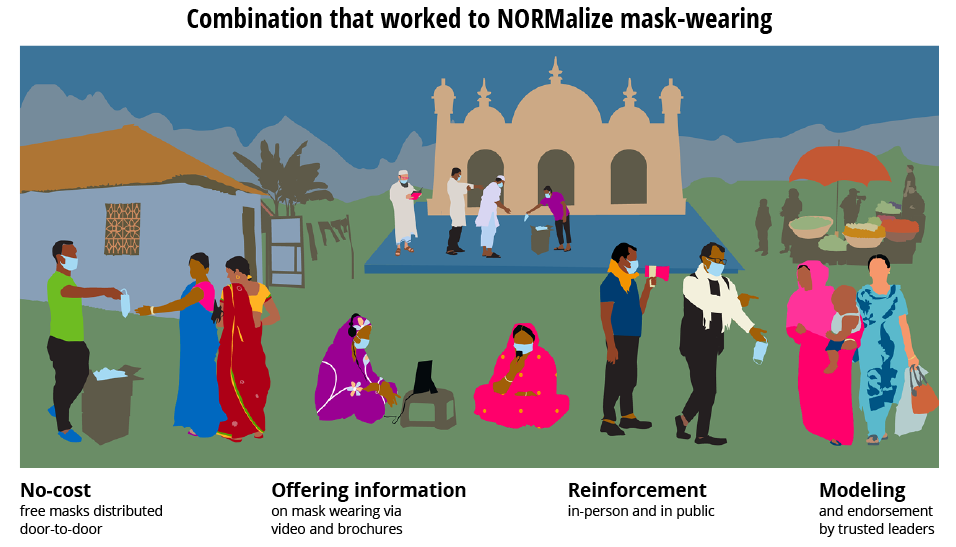Increasing Mask Use in India with the NORM model
Abstract
India's Self Employed Women's Association (SEWA) is scaling up the NORMalizing mask-wearing model to 3-4 million people in India.
IPA and its partners conducted a large-scale randomized evaluation in rural Bangladesh to rigorously test various strategies to increase mask-wearing. We found that a four-part model to change social norms of mask-wearing tripled mask usage at a low cost and was sustained 10 weeks into the intervention, even after the mask promotion ended. The model is now being scaled up in India to reach approximately 3-4 million people.

The Challenge
More than a year after the outbreak of the pandemic, COVID-19 continues to affect the lives of millions of people. In Southeast Asia, the pandemic is at its worst, with an alarming increase in cases, hospitalizations, and deaths. On May 1, India became the first one to register more than 400,000 new COVID-19 cases in a single day.[1] Insufficient tests and lack of medical treatment, particularly in rural areas, suggest that the spread of COVID-19 is even higher. Although vaccines bring hope for controlling the spread of the virus, they are not yet widely available in most countries. Wearing a face mask continues to be the best measure we have to control the spread of the virus, yet getting people to wear masks has been a public health challenge.
The Evidence
IPA partnered with Yale Research Initiative on Innovation and Scale (Y-RISE), Stanford University Medical School, a local NGO called Green Voice to rigorously test various strategies to increase mask-wearing. This research was funded by a grant directed by GiveWell from the Center for Effective Altruism. The large-scale randomized controlled trial (RCT) evaluation included 341,830 adults in 600 villages in rural Bangladesh. Researchers tested a portfolio of encouragement strategies to identify the precise combination needed to increase mask-wearing.
We found that a four-part model to change social norms of mask-wearing tripled mask usage at a low cost. We are calling the combination that worked N-O-R-M: No-cost free masks distribution, Offering information on mask-wearing, Reinforcement in-person and in public, and Modeling and endorsement by trusted leaders.

Results revealed that this model more than tripled mask use. In villages that received the intervention, mask use increased by 29 percentage points (from 13 percent in the comparison villages to 42 percent in treatment villages). Mask use was sustained 10 weeks into the intervention, even after the mask promotion ended. The intervention also increased physical distancing by 5 percentage points, contrary to concerns that mask-wearing would promote risky behavior giving people a false sense of security.
Read more about the study in the full policy brief and the academic paper.
The Impact
In India, the model is now being scaled up to reach approximately 3-4 million people.
In late April, the IPA research team shared these results with SEWA (Self-Employed Women’s Association), an organization with a membership base of 1.9 million poor self-employed women workers from the informal economy across 18 states in India with the goal of full employment and self-reliance. Given the current situation of the pandemic in India and the compelling evidence, SEWA decided to mobilize its network to implement the intervention in the state of Gujarat starting in early May 2021. SEWA will also begin the mask distribution in several other states in the first week of June 2021. They will be reaching 1 million member households, distributing 3-5 masks per household to cover all adults in each home. Women who are part of the organization are producing and distributing cloth masks. A philanthropist gave an additional gift which IPA used to secure surgical masks to distribute as part of reinforcement activities and provide technical support to monitor and adapt the intervention as necessary. The SEWA team is monitoring implementation with an app developed by the IPA team to allow for course correction.
Sources
[1] Johns Hopkins University & Medicine. “Coronavirus Resource Center”. https://coronavirus.jhu.edu/region/india












